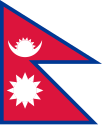Nepal
Nepal is alandlocked country in South Asia. It is located mainly in the Himalayas but also includes parts of the Indo-Gangetic Plain. With an estimated population of 26.4 million, it is 48th largest country by population and 93rd largest country by area.[2][14] It borders China in the north and India in the south, east, and west while Bangladesh is located within only 27 km (17 mi) of its southeastern tip and Bhutan is separated from it by the Indian state of Sikkim. Nepal has adiverse geography, including fertile plains,[15] subalpine forested hills, and eight of the world's ten tallest mountains, including Mount Everest, the highest point on Earth. Kathmandu is the nation's capital and largest city. Nepal is a multiethnic nation with Nepalias the official language.
The name "Nepal" is first recorded in texts from the Vedic period of the Indian subcontinent, the era in ancient Indiawhen Hinduism was founded, the predominant religion of the country. In the middle of the first millennium BCE,Gautama Buddha, the founder ofBuddhism, was born in Lumbini in southern Nepal. Parts of northern Nepal were intertwined with the culture ofTibet. The centrally located Kathmandu Valley is intertwined with the culture ofIndo-Aryans,[16] and was the seat of the prosperous Newar confederacy known as Nepal Mandala. The Himalayan branch of the ancient Silk Road was dominated by the valley's traders. The cosmopolitan region developed distinct traditional art and architecture. By the 18th century, the Gorkha Kingdomachieved the unification of Nepal. TheShah dynasty established the Kingdom of Nepal and later formed an alliance with the British Empire, under its RajputRana dynasty of premiers. The country was never colonised but served as a buffer state between Imperial China andBritish India.[17][18][19] Parliamentary democracy was introduced in 1951, but was twice suspended by Nepalese monarchs, in 1960 and 2005. TheNepalese Civil War in the 1990s and early 2000s resulted in the proclamation of a secular republic in 2008, ending the world's last Hindu monarchy.[20]
The Constitution of Nepal, adopted in 2015, establishes Nepal as a federalsecular parliamentary republic divided into seven provinces. Nepal was admitted to the United Nations in 1955, and friendship treaties were signed withIndia in 1950 and the People's Republic of China in 1960.[21][22] Nepal hosts the permanent secretariat of the South Asian Association for Regional Cooperation (SAARC), of which it is a founding member. Nepal is also a member of the Non Aligned Movementand the Bay of Bengal Initiative. Themilitary of Nepal is the fifth largest in South Asia; it is notable for its Gurkhahistory, particularly during the world wars, and has been a significant contributor to United Nations peacekeeping operations.




Comments
Post a Comment